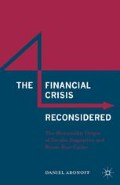Abstract
In this chapter I recommend policies and legislation that the US could undertake to address the issues raised in this book, related to the financial crisis and its aftermath. My purview is limited. The recommendations are high level, since a detailed analysis of each policy option lies beyond the scope of this book. Each proposal will meet with resistance from people and organizations who will be negatively impacted. I do not address the likely source of opposition, nor do I propose measures to overcome them. The recommendations are made solely on the basis of their impact on employment and GDP. The reader should understand that the narrowness of my focus does not denote a lack of concern about related issues; quite the contrary. But this book is about the determinants of employment and GDP, and a consideration of other matters is a subject for another book. Each of the following topics is addressed in turn:
-
Policies to alleviate the balance sheet recession.
-
Policies to restore competition to banking for its own sake and as a means to reduce the likelihood of future financial meltdowns.
-
Policies to reduce the Accumulation caused by current account deficits and income concentration that minimize the potential for damage to trade volumes and wealth creation.
Give me a one-handed economist! All my economists say, on the one hand … on the other.
—Harry S. Truman
Access this chapter
Tax calculation will be finalised at checkout
Purchases are for personal use only
Preview
Unable to display preview. Download preview PDF.
Notes
Former Fed governor Randall Kroszner pointed to precedent where the US government to nullified a clause in debt contracts that has become onerous. During the Great Depression, when the United States went off the gold standard, the dollar price of gold soared, which caused distress to borrowers on loans that had repayment tied to the value of gold. To alleviate borrower distress, the US government repudiated gold indexation clauses on all private contracts. At the time, gold indexation clauses appeared in almost all long-term debt contracts. Kroszner showed that the cancellation of debt led to an increase in asset values. See Randall Kroszner, Is It Better to Forgive Than to Receive? Repudiation of the Gold Indexation Clause in long-Term Debt during the Great Depression (University of Chicago, 1998).
See, for example, Arnold C. Herberger, “A Vision of the Growth Process,” American Economic Review, Vol. 88, Number 1 (1998): 1–32.
For an example of recent research on the topic of “too-big-to-fail,” which shows a negative correlation between the market to book value ration and the relative size of a bank, which indicates that size is actually value destroying, see Asli Demirguc-Kunt and Harry Huizinga, “Are Banks Too Big to Fail or Too Big to Save? International Evidence from Equity Prices and CDS Spreads,” Journal of Banking & Finance, Vol. 37, Issue 3 (March 2013): 875–894.
Milton Friedman and Anna Jacobson Schwartz, A Monetary History of the United States, 1867–1960 (Princeton University Press, 1963).
See “Regulatory Capital Rules: Regulatory Capital, Revisions to the Supplementary Leverage Ratio,” Federal Register, Vol. 79, Number 187 (September 26, 2014): 57725–57751.
J. M. Keynes, “Proposal for an International Clearing Union,” The International Monetary Fund 1945–1965 Volume III: Documents (1969 [1943]), pp. 19–36, available at http://imsreform.imf.org/reserve/pdf/keynesplan.pdf.
Ibid., p. 27; emphasis in the original.
Ibid., p. 28.
Ibid., p. 25.
Raj Chetty, Nathaniel Henderson, Patrick Kline, and Emmanuel Saez, “Is the United States Still a Land of Opportunity? Recent Trends in Intergenerational Mobility,” American Economic Review: Papers and Proceedings, Vol. 104, Number 5 (2014): 141–147.
David Autor, David Dorn, and Gordon H. Hanson, “The China Syndrome: Local Labor Market Effects of Import Competition in the United States,” American Economic Review, Vol. 103, Number 6 (2013): 2121–2168.
Copyright information
© 2016 Daniel Aronoff
About this chapter
Cite this chapter
Aronoff, D. (2016). Policy Options. In: The Financial Crisis Reconsidered. Palgrave Macmillan, New York. https://doi.org/10.1007/978-1-137-54789-7_14
Download citation
DOI: https://doi.org/10.1007/978-1-137-54789-7_14
Publisher Name: Palgrave Macmillan, New York
Print ISBN: 978-1-349-57547-3
Online ISBN: 978-1-137-54789-7
eBook Packages: Economics and FinanceEconomics and Finance (R0)

